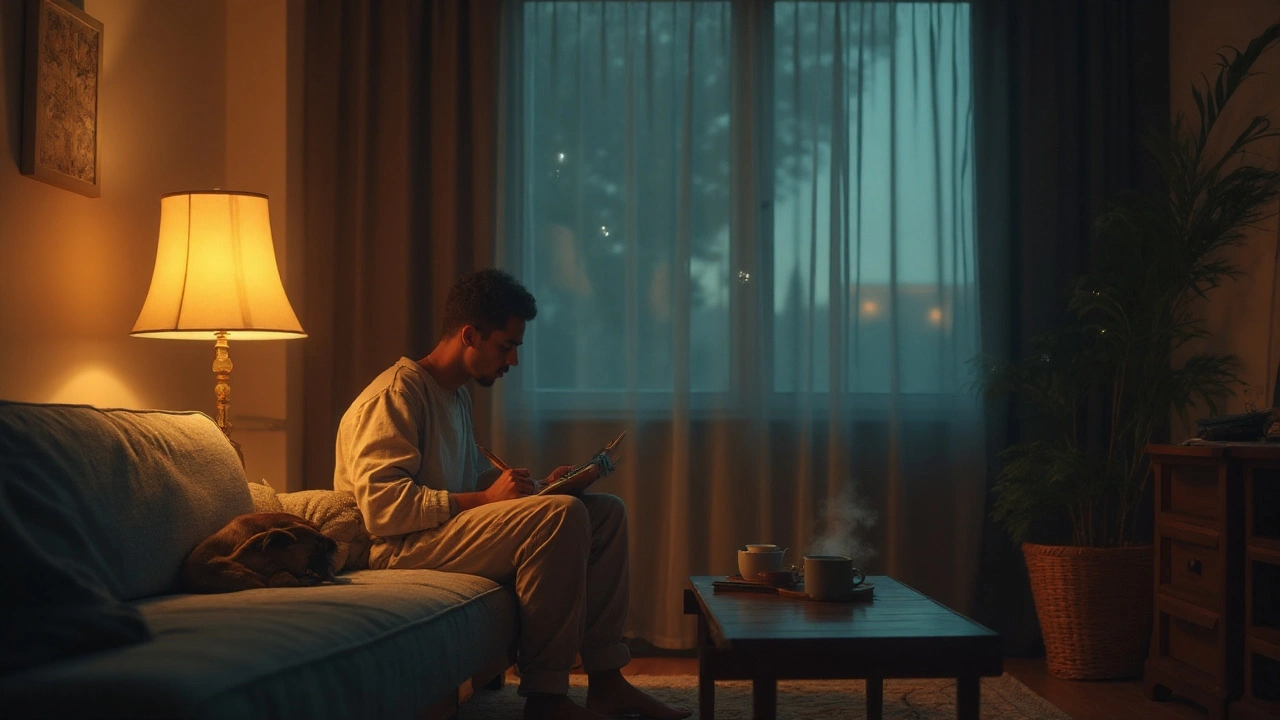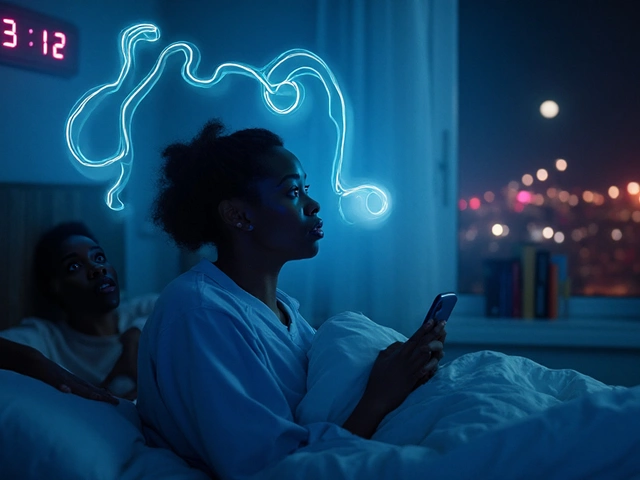If your brain hits panic mode the moment your head touches the pillow, you’re not broken-you’re caught in a loop. Anxiety makes it hard to fall and stay asleep. Poor sleep ramps up threat signals in the brain and fuels more anxiety the next day. The link is real, measurable, and fixable for many people. You won’t get miracle promises here; you’ll get what tends to work, what to rule out, and how to set yourself up for steady progress.
What you’ll get from this guide: a clear picture of why these two travel together, simple steps you can try this week, what to ask your GP, and how to pick between CBT‑I, therapy, or medical options in the UK.
TL;DR: Key takeaways
- The relationship is bidirectional. Poor sleep increases anxiety sensitivity; anxiety keeps the brain in a “threat on” state that blocks deep sleep.
- First job: decide if this is insomnia, sleep apnoea, restless legs, circadian timing issues, or trauma‑related sleep problems. Treatment depends on the cause.
- CBT‑I has the strongest evidence for chronic insomnia. It usually beats sleep pills long term and pairs well with therapy for anxiety.
- Morning light + consistent wake time + limiting time in bed are the fastest levers. Add wind‑down routines that lower body arousal, not just “good intentions.”
- Red flags to see your GP: loud snoring with breath pauses, leg urges that only calm when moving, panic awakenings most nights, or sleepiness that’s risky for driving.
Jobs you’re likely trying to get done after clicking this article:
- Understand how anxiety and sleep disorders feed each other so you can target the right thing.
- Choose a first‑line plan you can start this week.
- Decide when self‑help is enough and when to see a GP or therapist.
- Pick tools that are evidence‑backed (not random TikTok hacks).
- Troubleshoot common stuck points (nighttime panic, early waking, shift work).
Why anxiety and poor sleep lock together
Think of sleep as a seesaw between “drive to sleep” and “arousal.” Anxiety loads the arousal side. The brain’s alarm system (amygdala, locus coeruleus) stays twitchy, adrenaline and cortisol hang around, and the prefrontal “calm down” voice goes quiet. You might fall asleep, but you’ll wake light and jumpy. The next day, your brain misreads normal signals-like a stray email-as threats. Cue more anxiety, cue another rough night.
Here’s how it plays out across common sleep problems:
- Insomnia disorder: Trouble falling or staying asleep at least three nights a week for three months or more. Anxiety fuels “sleep effort” (trying hard to sleep), which backfires. Staying in bed awake trains your brain to link bed with stress. CBT‑I breaks that link.
- Obstructive sleep apnoea (OSA): Repeated airway collapses cause micro‑awakenings and low oxygen. You wake unrefreshed and on edge. Many people report anxiety or morning panic, which often eases once apnoea is treated (CPAP or mandibular devices).
- Restless legs syndrome (RLS) and periodic limb movements: An urge to move your legs in the evening, worse at rest. It wrecks sleep continuity and raises irritability and anxiety symptoms.
- Circadian rhythm delay: Your internal clock runs late. You can’t sleep at 11 p.m., but you can at 2 a.m. Early alarms cause chronic sleep loss-hello, next‑day anxiety. Timed light and wake anchors help.
- Nightmares and trauma‑linked sleep: The brain replays threats at night. You dread bedtime, sleep less, and feel unsafe the next day. Targeted therapies (like imagery rehearsal therapy) are key.
What the research says, in plain English: insomnia raises the future risk of anxiety, and anxiety raises the risk of insomnia. Treating either helps both. UK and international guidelines consistently recommend CBT‑I for chronic insomnia, and CPAP or oral devices for apnoea when indicated. Exercise, alcohol limits, and light exposure matter more than most gadgets.
“Offer cognitive behavioural therapy for insomnia (CBT‑I) as first‑line treatment for adults with chronic insomnia.” - NICE guideline (UK)
Two useful brain truths:
- The brain learns contexts. If you lie awake worrying in bed, the bed becomes a cue for alertness. Leave the bed when you can’t sleep; return when sleepy. That re‑trains the context.
- Physiology drives mood. A warm bath, then a cool bedroom; slow breathing; dim light-these nudge your nervous system toward “rest and digest,” making sleep more likely.

Step‑by‑step plan to break the loop
Start with a two‑week reset. No perfect days needed-just consistent, small levers that compound.
-
Rule out the big culprits.
- Possible apnoea? Loud snoring, witnessed breath pauses, dry mouth, morning headaches, or sleepiness that makes driving unsafe. If yes, book a GP appointment; ask about home sleep testing. If you have high blood pressure or a thicker neck, your odds are higher.
- Restless legs? Evening leg urges that ease with movement, worse when you’re still, plus poor sleep. Check iron with your GP; low ferritin often plays a role.
- Timing problem? You can sleep well at 2 a.m. but not at 11 p.m. That’s a clock issue. Treatment is light timing and regular wake time, not “try harder.”
- Medication check. Stimulants, some antidepressants, decongestants, and caffeine late in the day can all rev up your system. Talk to your GP before changing any prescription.
-
Lock a fixed wake time (even on weekends).
This is the anchor for your body clock and the fastest way to build sleep drive. If mornings are chaotic, pick the earliest time you can keep for 14 days, not your fantasy schedule.
-
Right‑size time in bed (CBT‑I principle).
Spend roughly the amount of time in bed that you’re actually sleeping (minimum 5.5-6 hours), then expand by 15 minutes every few nights you’re sleeping 85-90% of that time. If you’re in bed for 9 hours and sleep 6, start at 6.5-7 hours in bed. It feels counterintuitive; it works because it resets the sleep drive.
-
Cut pre‑sleep arousal, not just screen time.
- Wind‑down for 45-60 minutes. Think dim light, low‑stakes tasks, stretching, a warm shower or bath, paper book, gentle music.
- Use a “brain dump” page: write tomorrow’s to‑dos and a 3‑line plan. Close the notebook. Your brain relaxes when it knows the list is parked.
- Breath pacing: 4‑second inhale, 6‑second exhale, 5 minutes. It shifts you toward parasympathetic mode.
- Cool bedroom (16-18°C) and warm hands/feet. Temperature gradients help your body drift off.
-
Morning light and movement.
Get 10-30 minutes of outdoor light within an hour of waking, even if it’s grey and drizzly. Add a brisk walk or short workout. This advances your clock and steadies mood circuits. Light beats fancy supplements for timing your sleep.
-
Substance sanity.
- Caffeine: none after 2 p.m. if you’re sensitive; noon if you’ve got stress‑insomnia. Don’t quit abruptly if you drink a lot-taper.
- Alcohol: it can knock you out, but it fragments sleep and spikes 3 a.m. awakenings. Keep it light and early, or skip on rough weeks.
- Nicotene and THC: both can disrupt sleep architecture. If you’re using them to cope, consider alternatives and discuss with your GP.
-
Handle nighttime awakenings like a pro.
- If you’re awake and annoyed for ~20 minutes, get up. Low light. Boring activity. Return when sleepy. That’s stimulus control-core CBT‑I.
- Panic wake‑ups: sit, feet on floor, 1-2 minutes of slow extended exhale breathing. Remind yourself: “Panic is uncomfortable, not dangerous.” Then do a low‑stimulation task until drowsy.
-
Layer therapy when anxiety drives the show.
CBT for anxiety, acceptance‑based approaches, or trauma‑focused therapy can lower baseline arousal, making sleep improvements stick. In England, ask for NHS Talking Therapies via self‑referral or through your GP.
Medications? Short‑term sleep medicines may help during acute crises, but they don’t fix insomnia conditioning and can rebound on stopping. Antidepressants (like SSRIs) can reduce anxiety but sometimes disturb sleep at first; timing the dose or switching can help-work with your prescriber.
Tools, checklists, and data that actually help
Use these to guide decisions and track progress without turning sleep into a second job.
Simple sleep diary (7-14 days)-each morning, jot:
- Bedtime, time you fell asleep (rough guess), number of awakenings, final wake time, out of bed time.
- Estimated total sleep time, sleep quality (1-5), naps (yes/no, minutes), alcohol/caffeine after 3 p.m. (yes/no).
Quick screeners (not a diagnosis):
- Apnoea clues: loud snoring, observed pauses, morning headaches, high blood pressure, sleepiness. If you tick 2-3 of these, talk to your GP.
- RLS clues: urge to move legs at night, worse when still, better when moving, disrupts sleep.
- Circadian delay: can’t sleep early, but can sleep fine if allowed to wake late. Weekends feel great; weekdays feel awful.
Two‑week CBT‑I‑style experiment (adapt times to your life):
- Pick a fixed wake time (e.g., 6:30 a.m.). Stick to it daily.
- Set time in bed to average sleep time + 30-60 minutes (not less than 5.5-6 hours).
- Keep a 60‑minute wind‑down routine. Same order, same cues.
- Morning light walk. Rain jacket counts.
- If awake in bed and stressed, get up. Quiet activity. Back when sleepy.
- After 3-4 nights with 85-90% sleep efficiency, add 15 minutes to time in bed. If you drop below 80%, remove 15 minutes.
What to avoid:
- Clock watching. Cover it. Time guesses are fine.
- Long evening naps. If you must nap, do 15-20 minutes before 3 p.m.
- Chasing perfect sleep every night. Aim for a better weekly average.
Helpful add‑ons:
- White noise or a fan to mask bumps and bangs.
- Blue‑light filters or dimmers after sunset if you’re sensitive to light.
- Gentle yoga or progressive muscle relaxation in the evening.
Evidence snapshot (ranges reflect different studies and populations):
| Condition | Estimated prevalence in adults | Anxiety co‑occurrence | Key note |
|---|---|---|---|
| Insomnia disorder | ~10% chronic; up to 30-40% report symptoms | Common; insomnia increases later anxiety risk (roughly 2x in several cohorts) | CBT‑I improves sleep and reduces anxiety symptoms |
| Obstructive sleep apnoea | ~8-13% moderate‑to‑severe (varies by age/weight) | Many report anxiety; treatment often reduces daytime distress | Consider CPAP or mandibular devices via sleep clinic |
| Restless legs syndrome | ~2-5% | Anxiety symptoms frequent | Check ferritin; behavioural and medical options help |
| Circadian delay (DSWPD) | More common in teens/young adults | Social/academic stress heightens anxiety | Morning light + fixed wake; consider timed melatonin with GP advice |
Sources for the snapshot include NICE guidance, NHS resources, and major sleep medicine reviews. Exact numbers vary by study.

FAQ and next steps
How do I tell if it’s “just” anxiety or a separate sleep disorder? Look for physical clues. Loud snoring, choking/gasping, or extreme sleepiness point toward apnoea. Evening leg urges suggest RLS. If your sleep is fine when you can wake late, think circadian delay. If none fit and your mind races at night, insomnia driven by anxiety is likely. Your GP can help sort it.
Will CBT‑I make me more anxious because of sleep restriction? The first week can feel edgy. Keep caffeine modest, use gentle exercise, and stick to the plan. Most people sleep deeper by week two. The aim isn’t to “sleep less,” it’s to rebuild a strong sleep drive and restore bed‑sleep association.
What about sleep meds or supplements? Short‑term use can be a bridge during a crisis, but long‑term reliance can keep insomnia patterns alive. Melatonin helps with timing problems more than with classic insomnia, and dose/timing matter (often low dose, hours before bed). Always discuss with your GP, especially if you take other meds.
Can exercise help even if I’m exhausted? Yes. Light‑to‑moderate movement-walks, gentle cycling, yoga-improves sleep quality and anxiety. Finish vigorous training at least 3 hours before bed if you notice it revs you up.
Do wearables help? They’re fine for habits (steps, bedtime consistency). Don’t treat their sleep stages as medical truth-they estimate. If they make you obsessive, take a data holiday and stick to the diary.
Is waking at 3 a.m. always bad? No. Many humans wake briefly at night. The trouble starts when you clock‑watch, catastrophise, or lie in bed frustrated. Get up for a bit, keep lights low, and re‑cue sleepiness.
When should I see my GP urgently? If you nod off while driving, have breath pauses at night, or your mood spirals into thoughts of self‑harm. You don’t need to “earn” help by suffering longer.
What if I work shifts? Protect anchor sleep: 90-120 minutes of pre‑shift nap if needed, sunglasses on the commute home, cool/dark bedroom, and consistent meal timing. On days off, aim for a compromise schedule rather than flipping completely.
Menopause and midlife? Hot flushes, night sweats, and mood changes can hammer sleep. Cooling strategies, CBT‑I, and discussing HRT options with your GP can help.
Next steps by scenario
- Racing mind, no obvious medical triggers: start the two‑week CBT‑I‑style plan, add daily light + movement, and consider NHS Talking Therapies for anxiety skills.
- Snoring + daytime sleepiness: book a GP appointment to discuss apnoea assessment. In the meantime, side‑sleeping and reduced alcohol may help.
- Leg urges at night: ask your GP for ferritin and iron studies; behavioural strategies plus targeted treatment can make a big difference.
- Can sleep late but not early: set a firm wake time, get morning light, and discuss low‑dose timed melatonin with your GP if needed.
Credibility notes: This guide aligns with NHS and NICE recommendations: CBT‑I as first‑line for chronic insomnia; evaluation and treatment for sleep apnoea when symptoms suggest it; and psychological therapies for anxiety. Major sleep medicine reviews show that improving sleep reduces anxiety symptoms and that treating anxiety improves sleep-two doors into the same room.
None of this requires perfect willpower. It asks for a few repeated, boring behaviours that teach your body it’s safe to power down. Start with wake time, light, and time‑in‑bed rules; add the rest if you need it. Two weeks from now, you should see the first signs of relief: fewer 3 a.m. spirals, steadier days, and a brain that finally eases off the alarm.


Jake TSIS
This whole guide is just woke sleep propaganda. I sleep fine on 4 hours. If you can't handle life, that's your problem, not your brain's. Stop buying into this medicalized nonsense.
Akintokun David Akinyemi
The neurobiological interplay between amygdalar hyperactivity and HPA axis dysregulation is well-documented, but what's often overlooked is the role of circadian misalignment in low-resource settings. In Lagos, where power outages disrupt sleep architecture and noise pollution is endemic, CBT-I must be adapted with community-based sleep hygiene champions. The evidence is solid, but scalability requires context-sensitive implementation. Also, ferritin levels? Crucial. Many African populations are iron-deficient without knowing it.
Jasmine Hwang
ok but like... why is everyone so obsessed with sleep? i mean, i just nap when i'm tired. why do i need a 12-step plan to fall asleep? this feels like a cult. also, who even has time for a 60-min wind-down? i have a kid. and a job. and a cat that sits on my face at 3am. #relatable
liam coughlan
I’ve tried the sleep restriction thing. Felt like a zombie for a week. But by week two? My brain stopped screaming at night. Not magic. Just science. Stick with it.
Maeve Marley
I just want to say how much I appreciate this guide - seriously, it’s the first time I’ve read something that doesn’t make me feel broken. I’ve been dealing with nighttime panic attacks for years, and the part about getting up and doing a low-stimulus task? That was a game-changer. I started reading old magazines in the kitchen under a dim lamp, no phone, just paper. And you know what? I actually fell asleep before I finished the article. I cried a little. Not because I was sad - because for the first time in years, I felt like my brain could finally rest. To anyone reading this: you’re not failing. You’re just in a loop. And loops can be broken. Slowly. Gently. One exhale at a time.
James Gonzales-Meisler
The article is well-structured and evidence-based, but it contains a grammatical inconsistency: 'you’ll get what tends to work' should be 'you’ll get what tend to work' if 'what' refers to plural 'steps.' Also, 'CBT‑I' is inconsistently hyphenated - some instances use en dashes, others em dashes. Minor, but jarring in an otherwise meticulous piece.
Navin Kumar Ramalingam
Look, I get it. CBT-I sounds cool. But let’s be real - most of this is just common sense wrapped in academic jargon. I don’t need a 7-step plan to stop checking my phone before bed. I just need to stop being a slave to productivity culture. Also, why is everyone so obsessed with 16°C? I live in Mumbai. My AC doesn’t go that low. Maybe the real issue isn’t sleep hygiene - it’s capitalism.